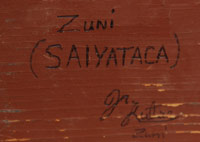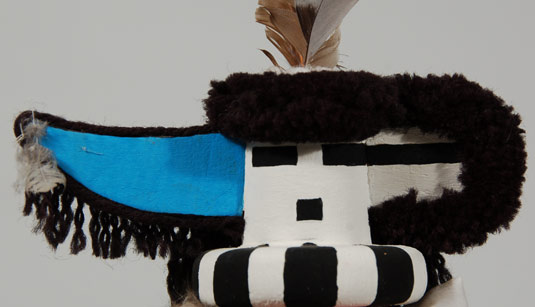Zuni Pueblo Saiyatasha Katsina Doll [SOLD]
+ Add to my watchlist Forward to Friend
- Category: Traditional
- Origin: Zuni Pueblo, SHE-WE-NA
- Medium: wood, fabric, feathers, string
- Size: 12” tall
- Item # C3450.13 SOLD
Saiyatasha, the Rain Priest of the North, is an important kachina and the foremost impersonation in the Shalako Ceremony, where he makes his only appearance. He brings all manner of benefits to the Zuni, from the control of weather to longevity and protection from enemies (Parsons 1939). He is spoken of as the Bow Priest and is the orchestrator of the Shalako Ceremony.
Zuni informants to Ruth Bunzel stated that his name “Long Horn” (saiya for horn, and tasha for long) is to signify that he brings long life to the people. His small right eye is for the witches so their lives will be short, and the long left eye is for the good people to give them long lives. Long Horn is also considered to be both a warrior and a hunter who brings the deer to Zuni. Because he is also a priest, he wears the feathers of that station on the crown of his head (Bunzel 1929-1930).
 During his incumbency, the impersonator of Saiyatasha holds a position of great responsibility, power, and prestige and assumes the rank and importance of one of the major priests of Zuni. He is referred to only by his title, Saiyatasha Mosona, as a mark of respect by the people of Zuni and is expected to become a paragon of Zuni virtues as well as a devoutly responsible priest for the period of one year. For the impersonator, it is a demanding role since he is responsible for the calendar and must decide whether the first prayer-stick planting for the Shalako will be during the first quarter or full moon; then he must maintain a watch over the phases of the moon for the remainder of the year. He must notify the Shalako impersonators four days ahead of their time to plant prayer sticks and then join them in this ritual. He must coordinate with the Pekwins so that the Shalako and Winter Solstice Ceremonies do not overlap. He also must learn from the cult leader all of the lengthy prayers, chants, and speeches, while attending nightly meetings that last from the Zuni New Year until Shalako. In addition, he is required to make journeys to springs from four to eight miles distant to offer prayers each month during the year and more frequently as the Shalako approaches. He must also pray to the sun each day and work to prevent the frosts of spring and fall since he represents a kachina who makes the days warm. (Wright 1985)
During his incumbency, the impersonator of Saiyatasha holds a position of great responsibility, power, and prestige and assumes the rank and importance of one of the major priests of Zuni. He is referred to only by his title, Saiyatasha Mosona, as a mark of respect by the people of Zuni and is expected to become a paragon of Zuni virtues as well as a devoutly responsible priest for the period of one year. For the impersonator, it is a demanding role since he is responsible for the calendar and must decide whether the first prayer-stick planting for the Shalako will be during the first quarter or full moon; then he must maintain a watch over the phases of the moon for the remainder of the year. He must notify the Shalako impersonators four days ahead of their time to plant prayer sticks and then join them in this ritual. He must coordinate with the Pekwins so that the Shalako and Winter Solstice Ceremonies do not overlap. He also must learn from the cult leader all of the lengthy prayers, chants, and speeches, while attending nightly meetings that last from the Zuni New Year until Shalako. In addition, he is required to make journeys to springs from four to eight miles distant to offer prayers each month during the year and more frequently as the Shalako approaches. He must also pray to the sun each day and work to prevent the frosts of spring and fall since he represents a kachina who makes the days warm. (Wright 1985)
This Katsina doll is signed with a name that appears to be Jr Lutse but is not completely discernable. It is an excellent representation of this katsina and the clothing is spectacular.
Condition: excellent original condition
Provenance: from the personal collection of Chuck and Jan Rosenak, collectors and authors of Navajo folk art.
References:
Bunzel, Ruth L., Introduction to Zuni Ceremonialism, Zuni Origin Myths, Zuni Ritual Poetry, Zuni Kachinas. Forty-seventh Annual Report of the Bureau of American Ethnology, Washington, DC. 1929-30.
Wright, Barton, Kachinas of the Zuni, Northland Press & Southwest Museum. 1985

- Category: Traditional
- Origin: Zuni Pueblo, SHE-WE-NA
- Medium: wood, fabric, feathers, string
- Size: 12” tall
- Item # C3450.13 SOLD



